Los Baños

When the nips recently had their earthquake the whole world cried out in sympathy. It was like saying, not your fault not you are too fucking stupid to not realise building a Nuclear power station next to the sea is not a good idea in a tidal wave area and not your fault that your population are too dumb to protest about it. (be careful in the USA because the same situation applies in the station on the sea near Diablo Canyon).
No everyone said what a great people the nips are-like fuck they are.They lost nearly every battle with the allies for the same reason they had the tidal wave disaster for no one questions anything. One of the greatest americans of the last fifty years M.Ali said that he had nothing against the viet gong so why should he go fight them, thats intelligence.He questioned the policy.
This is a story about another great American thing , the paras, who nearly every time they fought the nips beat them.And this all proves that contrary to popular belief the Nips were beatable at any given time.
Los Baños, Calabarzon, Philippines
No everyone said what a great people the nips are-like fuck they are.They lost nearly every battle with the allies for the same reason they had the tidal wave disaster for no one questions anything. One of the greatest americans of the last fifty years M.Ali said that he had nothing against the viet gong so why should he go fight them, thats intelligence.He questioned the policy.
This is a story about another great American thing , the paras, who nearly every time they fought the nips beat them.And this all proves that contrary to popular belief the Nips were beatable at any given time.
Los Baños, Calabarzon, Philippines
On February 23, 1945, U.S. paratroopers and Filipino guerrillas saved 2,147 prisoners of war at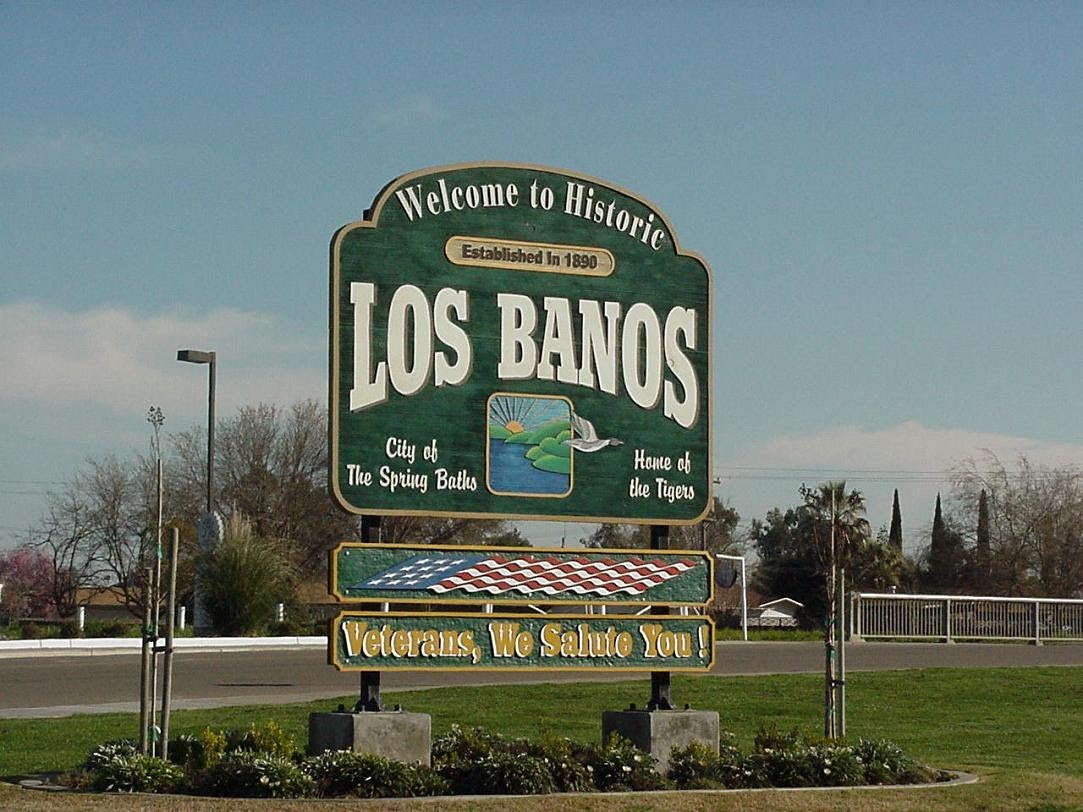 Los Baños. It was one of the most successful rescues in modern history. Two paratroopers and POWs were killed, along with 80 Japanese.The raid at Los Baños in the Philippines,
Los Baños. It was one of the most successful rescues in modern history. Two paratroopers and POWs were killed, along with 80 Japanese.The raid at Los Baños in the Philippines,  early Friday morning on 23 February 1945, was executed by a combined U.S. Army Airborne.Above Manila .
early Friday morning on 23 February 1945, was executed by a combined U.S. Army Airborne.Above Manila . and Filipino guerrilla task force, resulting in the liberation of 2,147 Allied civilian and military internees from an agricultural school campus turned Japanese internment camp
and Filipino guerrilla task force, resulting in the liberation of 2,147 Allied civilian and military internees from an agricultural school campus turned Japanese internment camp . It has been celebrated as one of the most successful rescue operations in modern military history. It was the second precisely-executed raid by combined U.S.-Filipino forces within a
. It has been celebrated as one of the most successful rescue operations in modern military history. It was the second precisely-executed raid by combined U.S.-Filipino forces within a 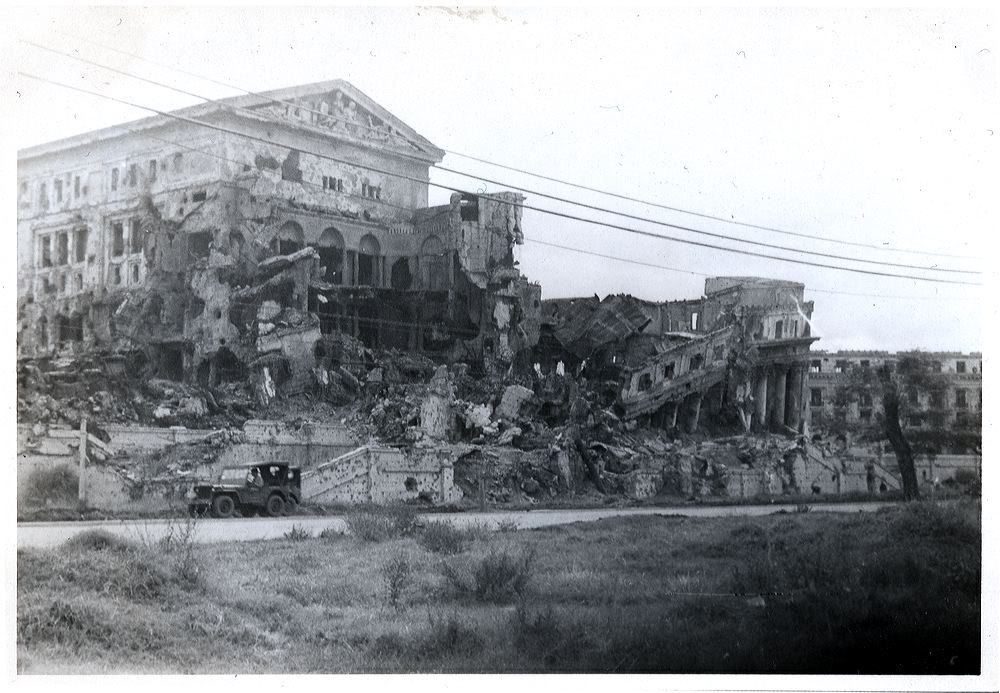 month, following on the heels of the Raid at Cabanatuan at Luzon on 30 January, in which 512 Allied military POWs had been rescued.Above Manila
month, following on the heels of the Raid at Cabanatuan at Luzon on 30 January, in which 512 Allied military POWs had been rescued.Above Manila Since the landings of the U.S. Sixth Army at Lingayen Gulf
Since the landings of the U.S. Sixth Army at Lingayen Gulf  and the U.S. Eighth Army at Nasugbu, Batangas on 9 January 1945 and 31 January 1945 respectively, to retake Luzon,
and the U.S. Eighth Army at Nasugbu, Batangas on 9 January 1945 and 31 January 1945 respectively, to retake Luzon, the Imperial Japanese Army was being repeatedly pushed back and was increasingly becoming desperate. Soon news was filtering (below Manila)
the Imperial Japanese Army was being repeatedly pushed back and was increasingly becoming desperate. Soon news was filtering (below Manila)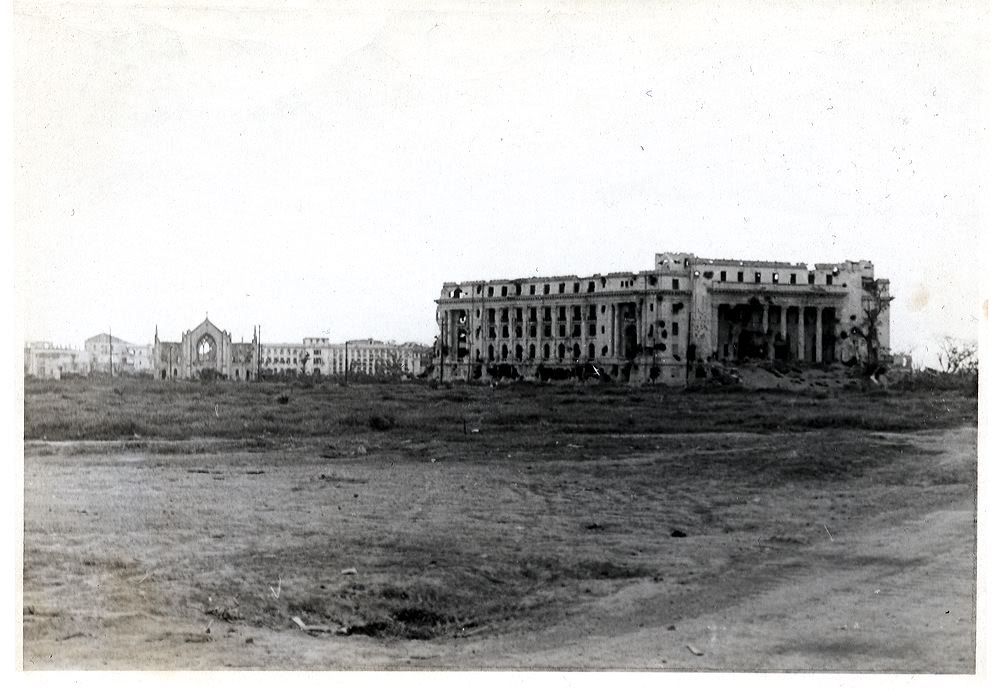 down to Allied commanders that the Japanese were killing innocent civilians and prisoners of war while falling back.
down to Allied commanders that the Japanese were killing innocent civilians and prisoners of war while falling back.
By 20 February 1945, the conditions on Luzon turned favorable, such that the various elements could be withdrawn from combat and apprised of their mission. They were ordered to their staging posts and readied to go, with the raid scheduled for 07:00 on 23 February.On 3 February 1945, Gen. Swing was tasked with a rescue mission to rescue the internees at the Los Baños camp, some twenty-five miles (40 km) behind the Japanese lines. However, with the 11th Airborne committed to a series of pitched battles south of Manila and the resolute Japanese defense atNichols Field and Fort McKinley
Japanese defense atNichols Field and Fort McKinley , immediate deployment was out of the question. As an interim measure, Maj. Gen. Swing ordered his subordinates to develop a plan that could be implemented at the earliest possible moment. Then on 18 February, the 1st Battalion, 511th Parachute Infantry Regiment, under Major Henry Burgess, the main unit assigned to carry out the mission, was pulled out from its battlefield position on the so-called Genko Line, a fortified system of interlocking pillboxes and anti-tank fortifications running along the southern Manila district of Las Piñas and proceeded to
, immediate deployment was out of the question. As an interim measure, Maj. Gen. Swing ordered his subordinates to develop a plan that could be implemented at the earliest possible moment. Then on 18 February, the 1st Battalion, 511th Parachute Infantry Regiment, under Major Henry Burgess, the main unit assigned to carry out the mission, was pulled out from its battlefield position on the so-called Genko Line, a fortified system of interlocking pillboxes and anti-tank fortifications running along the southern Manila district of Las Piñas and proceeded to  Parañaquedistrict to rest and regroup.
Parañaquedistrict to rest and regroup.
At 04:00 on 23 February 1945 the 1st Battalion 511PIR (less B Company) boarded fifty-four amphibious tractors (Amtracs), slipped into Laguna de Bay, and headed for Mayondon Point. They also managed to reach their destination without alerting any Japanese defenders and headed off for the remaining 2 miles (3.2 km) overland journey to the camp, aiming to arrive just after 07:00.Hours before 07:00, guerrillas of the 45th Hunters-ROTC Regiment had stealthily assumed their designated positions around the camp, and they waited for Lt. Skau's Recon Platoon to signal the start of the assault.
A few days after the rescue, the Japanese in full force, led by the escaped Sadaaki Konishi, returned to Los Baños. Upon seeing that there were no POWs in sight, the Japanese turned their wrath on the remaining civilians in town who had failed to heed the warning from the guerrillas to leave. With the help of pro-Japanese MAKAPILI, the Japanese massacred some 1,500 men, women and children, and burned their homes, as well as those in the adjacent towns suspected of collaborating with the liberators. Konishi was tried for his war crimes after the war and hanged.

 Los Baños. It was one of the most successful rescues in modern history. Two paratroopers and POWs were killed, along with 80 Japanese.The raid at Los Baños in the Philippines,
Los Baños. It was one of the most successful rescues in modern history. Two paratroopers and POWs were killed, along with 80 Japanese.The raid at Los Baños in the Philippines,  early Friday morning on 23 February 1945, was executed by a combined U.S. Army Airborne.Above Manila .
early Friday morning on 23 February 1945, was executed by a combined U.S. Army Airborne.Above Manila . and Filipino guerrilla task force, resulting in the liberation of 2,147 Allied civilian and military internees from an agricultural school campus turned Japanese internment camp
and Filipino guerrilla task force, resulting in the liberation of 2,147 Allied civilian and military internees from an agricultural school campus turned Japanese internment camp . It has been celebrated as one of the most successful rescue operations in modern military history. It was the second precisely-executed raid by combined U.S.-Filipino forces within a
. It has been celebrated as one of the most successful rescue operations in modern military history. It was the second precisely-executed raid by combined U.S.-Filipino forces within a  month, following on the heels of the Raid at Cabanatuan at Luzon on 30 January, in which 512 Allied military POWs had been rescued.Above Manila
month, following on the heels of the Raid at Cabanatuan at Luzon on 30 January, in which 512 Allied military POWs had been rescued.Above Manila Since the landings of the U.S. Sixth Army at Lingayen Gulf
Since the landings of the U.S. Sixth Army at Lingayen Gulf  and the U.S. Eighth Army at Nasugbu, Batangas on 9 January 1945 and 31 January 1945 respectively, to retake Luzon,
and the U.S. Eighth Army at Nasugbu, Batangas on 9 January 1945 and 31 January 1945 respectively, to retake Luzon, the Imperial Japanese Army was being repeatedly pushed back and was increasingly becoming desperate. Soon news was filtering (below Manila)
the Imperial Japanese Army was being repeatedly pushed back and was increasingly becoming desperate. Soon news was filtering (below Manila) down to Allied commanders that the Japanese were killing innocent civilians and prisoners of war while falling back.
down to Allied commanders that the Japanese were killing innocent civilians and prisoners of war while falling back.
General Douglas MacArthur although deeply alarmed about his own safety and furniture was said to be deeply 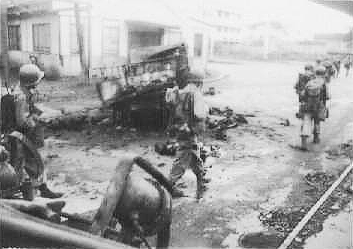 alarmed about the plight of thousands of prisoners who had been interned in various camps on Luzon,
alarmed about the plight of thousands of prisoners who had been interned in various camps on Luzon, since the early days of the Pacific War. There was concern that, with deliverance so near, they might be killed.
since the early days of the Pacific War. There was concern that, with deliverance so near, they might be killed. 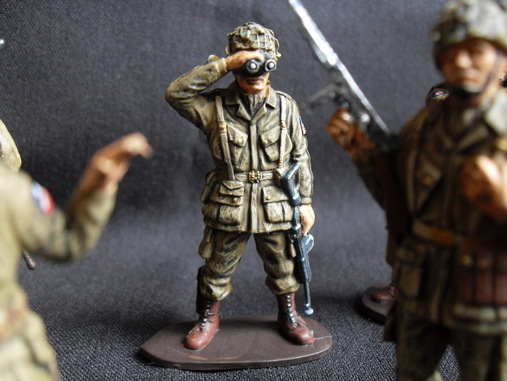 Earlier, some daring raids were carried out to rescue POWs, including one at Cabanatuan and at the University of Santo Tomas
Earlier, some daring raids were carried out to rescue POWs, including one at Cabanatuan and at the University of Santo Tomas and Bilibid Prison at the height for the battle of Manila
and Bilibid Prison at the height for the battle of Manila .In Los Baños, Laguna, at the Philippine Agricultural College and Forestry Campus, now called the University of the Philippines at Los Baños,
.In Los Baños, Laguna, at the Philippine Agricultural College and Forestry Campus, now called the University of the Philippines at Los Baños, which was located on a 60-acre (240,000 m2) site, was the POW and civilian internment camp, wedged between the foothills of Mount Makiling
which was located on a 60-acre (240,000 m2) site, was the POW and civilian internment camp, wedged between the foothills of Mount Makiling and the northern shore of Los Baños facing Laguna de Bay. The main internment building was inside Baker Hall, a gymnasium, where most internees had been incarcerated since 1942.
and the northern shore of Los Baños facing Laguna de Bay. The main internment building was inside Baker Hall, a gymnasium, where most internees had been incarcerated since 1942.
 alarmed about the plight of thousands of prisoners who had been interned in various camps on Luzon,
alarmed about the plight of thousands of prisoners who had been interned in various camps on Luzon, since the early days of the Pacific War. There was concern that, with deliverance so near, they might be killed.
since the early days of the Pacific War. There was concern that, with deliverance so near, they might be killed.  Earlier, some daring raids were carried out to rescue POWs, including one at Cabanatuan and at the University of Santo Tomas
Earlier, some daring raids were carried out to rescue POWs, including one at Cabanatuan and at the University of Santo Tomas and Bilibid Prison at the height for the battle of Manila
and Bilibid Prison at the height for the battle of Manila .In Los Baños, Laguna, at the Philippine Agricultural College and Forestry Campus, now called the University of the Philippines at Los Baños,
.In Los Baños, Laguna, at the Philippine Agricultural College and Forestry Campus, now called the University of the Philippines at Los Baños, and the northern shore of Los Baños facing Laguna de Bay. The main internment building was inside Baker Hall, a gymnasium, where most internees had been incarcerated since 1942.
and the northern shore of Los Baños facing Laguna de Bay. The main internment building was inside Baker Hall, a gymnasium, where most internees had been incarcerated since 1942.
Surrounded by barbed wire fences in clusters of hatched huts were 8,146 POWs: 7,000 Filipinos, 1,527 Americans, 329 British, 133 Australians, 89 Dutch, 30 Norwegians, 22 Poles, 16 Italians, and 1 Nicaraguan. Aside from eleven navy nurses under the command of Chief Nurse Laura M. Cobb (some of U.S. military nurses
Aside from eleven navy nurses under the command of Chief Nurse Laura M. Cobb (some of U.S. military nurses 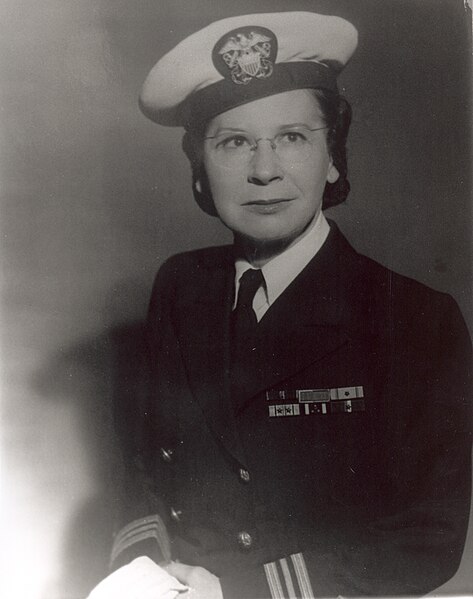 known as the "Angels of Bataan and Corregidor") and a few servicemen, most of the internees were civilian businessmen, teachers, bankers, and
known as the "Angels of Bataan and Corregidor") and a few servicemen, most of the internees were civilian businessmen, teachers, bankers, and  missionaries caught by the Japanese during the course of the war and incarcerated in various POW camps in the country.
missionaries caught by the Japanese during the course of the war and incarcerated in various POW camps in the country.
 Aside from eleven navy nurses under the command of Chief Nurse Laura M. Cobb (some of U.S. military nurses
Aside from eleven navy nurses under the command of Chief Nurse Laura M. Cobb (some of U.S. military nurses  known as the "Angels of Bataan and Corregidor") and a few servicemen, most of the internees were civilian businessmen, teachers, bankers, and
known as the "Angels of Bataan and Corregidor") and a few servicemen, most of the internees were civilian businessmen, teachers, bankers, and  missionaries caught by the Japanese during the course of the war and incarcerated in various POW camps in the country.
missionaries caught by the Japanese during the course of the war and incarcerated in various POW camps in the country.
On 14 May 1943, as the prisoner population at the University of Santo Tomas internment camp rose to  unmanageable levels, the internees were transferred to the new Los Baños facility, some seventy kilometers (45 mi) away from Manila.
unmanageable levels, the internees were transferred to the new Los Baños facility, some seventy kilometers (45 mi) away from Manila.

While incarcerated, the POWs had formed a committee to deal with the guards for self-governing purposes and to obtain whatever marginal freedom or concessions they could obtain from the Japanese prison authorities.  Nonetheless, the internees were made to get by on dwindling rations, limited clothing, poor housing and non-existent sanitation, and endure the sadistic tendencies of the camp guards. By early 1945, the conditions in the camp turned hellish, with enforced limited rations and mounting abuse, courtesy of the camp's second-in-command, Warrant Officer Sadaaki Konishi.
Nonetheless, the internees were made to get by on dwindling rations, limited clothing, poor housing and non-existent sanitation, and endure the sadistic tendencies of the camp guards. By early 1945, the conditions in the camp turned hellish, with enforced limited rations and mounting abuse, courtesy of the camp's second-in-command, Warrant Officer Sadaaki Konishi. The U.S. 11th Airborne Division under Maj. Gen. Joseph Swing arrived in the southwest Pacific in mid-1944. Prior to taking part in the invasion of Leyte in October, the division had
The U.S. 11th Airborne Division under Maj. Gen. Joseph Swing arrived in the southwest Pacific in mid-1944. Prior to taking part in the invasion of Leyte in October, the division had  undergone theater combat training in New Guinea. Together with the 503rd Parachute Regimental Combat Team, these were the only U.S. Army airborne forces in the Pacific theater of operations. After Leyte, the 188th Glider Infantry Regiment landed at Nasugbu with the U.S. Eighth Army on 31 January, while the 511th Parachute Infantry Regiment parachuted into Tagaytay Ridge, south of Manila as a diversionary assault.
undergone theater combat training in New Guinea. Together with the 503rd Parachute Regimental Combat Team, these were the only U.S. Army airborne forces in the Pacific theater of operations. After Leyte, the 188th Glider Infantry Regiment landed at Nasugbu with the U.S. Eighth Army on 31 January, while the 511th Parachute Infantry Regiment parachuted into Tagaytay Ridge, south of Manila as a diversionary assault.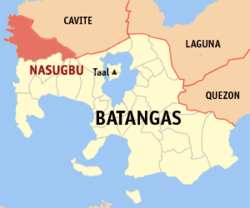
 The U.S. 11th Airborne Division under Maj. Gen. Joseph Swing arrived in the southwest Pacific in mid-1944. Prior to taking part in the invasion of Leyte in October, the division had
The U.S. 11th Airborne Division under Maj. Gen. Joseph Swing arrived in the southwest Pacific in mid-1944. Prior to taking part in the invasion of Leyte in October, the division had  undergone theater combat training in New Guinea. Together with the 503rd Parachute Regimental Combat Team, these were the only U.S. Army airborne forces in the Pacific theater of operations. After Leyte, the 188th Glider Infantry Regiment landed at Nasugbu with the U.S. Eighth Army on 31 January, while the 511th Parachute Infantry Regiment parachuted into Tagaytay Ridge, south of Manila as a diversionary assault.
undergone theater combat training in New Guinea. Together with the 503rd Parachute Regimental Combat Team, these were the only U.S. Army airborne forces in the Pacific theater of operations. After Leyte, the 188th Glider Infantry Regiment landed at Nasugbu with the U.S. Eighth Army on 31 January, while the 511th Parachute Infantry Regiment parachuted into Tagaytay Ridge, south of Manila as a diversionary assault.
By 20 February 1945, the conditions on Luzon turned favorable, such that the various elements could be withdrawn from combat and apprised of their mission. They were ordered to their staging posts and readied to go, with the raid scheduled for 07:00 on 23 February.On 3 February 1945, Gen. Swing was tasked with a rescue mission to rescue the internees at the Los Baños camp, some twenty-five miles (40 km) behind the Japanese lines. However, with the 11th Airborne committed to a series of pitched battles south of Manila and the resolute
 Japanese defense atNichols Field and Fort McKinley
Japanese defense atNichols Field and Fort McKinley , immediate deployment was out of the question. As an interim measure, Maj. Gen. Swing ordered his subordinates to develop a plan that could be implemented at the earliest possible moment. Then on 18 February, the 1st Battalion, 511th Parachute Infantry Regiment, under Major Henry Burgess, the main unit assigned to carry out the mission, was pulled out from its battlefield position on the so-called Genko Line, a fortified system of interlocking pillboxes and anti-tank fortifications running along the southern Manila district of Las Piñas and proceeded to
, immediate deployment was out of the question. As an interim measure, Maj. Gen. Swing ordered his subordinates to develop a plan that could be implemented at the earliest possible moment. Then on 18 February, the 1st Battalion, 511th Parachute Infantry Regiment, under Major Henry Burgess, the main unit assigned to carry out the mission, was pulled out from its battlefield position on the so-called Genko Line, a fortified system of interlocking pillboxes and anti-tank fortifications running along the southern Manila district of Las Piñas and proceeded to  Parañaquedistrict to rest and regroup.
Parañaquedistrict to rest and regroup.
For the jump phase of the assault plan, the 511th regimental commander, Lt. Col. Edward Lahti appointed Company B, 1st Battalion, 511th Parachute Infantry Regiment of the 11th Airborne Division under 1Lt. John Ringler together with the Headquarters Company Light Machine Gun Platoon of 1Lt. Walter Hettlinger.
The 188th Glider Infantry Regiment of Colonel Robert Soule had perhaps the most daunting task; trying to stave off a counterattack from the main highway. Bivouacked across the San Juan River were some 8,000 Japanese troops of the 8th "Tiger" Division, commanded by Lt. Gen. Shizuo Yokoyama.

Casualties were expected to be high, but the risks were deemed to be worth it. The success of the mission would depend on speed and surprise.The various Filipino guerrilla groups operating in the vicinity of Los Baños played a key role that led to the successful liberation of the camp. Earlier, in the partisan war against the Japanese, a combined guerrilla command was formed to bring some order to the effort by the defunct USAFFE command, which was in charge of unconventional forces in the Philippines, and renamed as the General Guerrilla Command (GGC) of Luzon under Maj. Jay D. Vanderpool of the U.S. Army.
Under the GGC, the Hunters ROTC (Reserve Officers Training Corps) guerrillas, made up originally of former cadets of the Philippine Military Academy along with some former ROTC and college students under the command of Col. Frank Quesada were one of the most active groups. Other formations include President Quezon's Own Guerrillas (PQOG) under Col. Fil Avanceña, Red Lion's Unit, the Filipino-Chinese 48th Squadron and the Villegas group of the Marxist Hukbalahaps were tasked by the GGC to coordinate operations related to Los Baños.

Among the members of Hunters-ROTC guerillas who participated in the raid was the future Filipino film star Mario Montenegro, then only sixteen years old.Long before the arrival of the U.S. liberation forces, the guerrillas conducted intelligence operations that gathered precise inside information about the POWs in Los Baños and their guards. Many prisoners were long-time friends of partisan families before the war. With Lt. Col. Gustavo Ingles designated as overall guerrilla coordinator with the 11th Airborne Division, information was shared with Maj. Gen. Swing's Command Staff, including Col. Henry Muller (G-2), and Col. Douglas Quandt (G-3), as well as other top planners, who fine-tuned the final strategy. On 12 February, Freddy Zervoulakas, a 19-year old Greek-Filipino, slipped out of the camp and made contact with the guerrillas. He was sent back into the camp with the promise that the internees will be rescued. But the internee committee decided that it would be best for the prisoners to do nothing. A week later, another escapee from the camp, a civilian engineer named Pete Miles, gave further valuable information to the 11th A/B Division planners, including the daily routine in the camp, details of troop positions and the exact location of the internees. This proved a great asset to the planners and enabled them to finalize the four-phase plan that was timed to coincide with the guards’ exercise period, which was conducted by the Japanese troops without clothing, equipment, or weapons, thereby minimizing the risk of harm to the internees during the rescue. Other internees managed to escape from the camp days before the raid.Meanwhile, Lt. Roger Miller, with two enlisted men, left to make a reconnaissance of the drop zone. They were instructed to return to the unit for debriefing and to jump with B Company.
On 12 February, Freddy Zervoulakas, a 19-year old Greek-Filipino, slipped out of the camp and made contact with the guerrillas. He was sent back into the camp with the promise that the internees will be rescued. But the internee committee decided that it would be best for the prisoners to do nothing. A week later, another escapee from the camp, a civilian engineer named Pete Miles, gave further valuable information to the 11th A/B Division planners, including the daily routine in the camp, details of troop positions and the exact location of the internees. This proved a great asset to the planners and enabled them to finalize the four-phase plan that was timed to coincide with the guards’ exercise period, which was conducted by the Japanese troops without clothing, equipment, or weapons, thereby minimizing the risk of harm to the internees during the rescue. Other internees managed to escape from the camp days before the raid.Meanwhile, Lt. Roger Miller, with two enlisted men, left to make a reconnaissance of the drop zone. They were instructed to return to the unit for debriefing and to jump with B Company.
 On 12 February, Freddy Zervoulakas, a 19-year old Greek-Filipino, slipped out of the camp and made contact with the guerrillas. He was sent back into the camp with the promise that the internees will be rescued. But the internee committee decided that it would be best for the prisoners to do nothing. A week later, another escapee from the camp, a civilian engineer named Pete Miles, gave further valuable information to the 11th A/B Division planners, including the daily routine in the camp, details of troop positions and the exact location of the internees. This proved a great asset to the planners and enabled them to finalize the four-phase plan that was timed to coincide with the guards’ exercise period, which was conducted by the Japanese troops without clothing, equipment, or weapons, thereby minimizing the risk of harm to the internees during the rescue. Other internees managed to escape from the camp days before the raid.Meanwhile, Lt. Roger Miller, with two enlisted men, left to make a reconnaissance of the drop zone. They were instructed to return to the unit for debriefing and to jump with B Company.
On 12 February, Freddy Zervoulakas, a 19-year old Greek-Filipino, slipped out of the camp and made contact with the guerrillas. He was sent back into the camp with the promise that the internees will be rescued. But the internee committee decided that it would be best for the prisoners to do nothing. A week later, another escapee from the camp, a civilian engineer named Pete Miles, gave further valuable information to the 11th A/B Division planners, including the daily routine in the camp, details of troop positions and the exact location of the internees. This proved a great asset to the planners and enabled them to finalize the four-phase plan that was timed to coincide with the guards’ exercise period, which was conducted by the Japanese troops without clothing, equipment, or weapons, thereby minimizing the risk of harm to the internees during the rescue. Other internees managed to escape from the camp days before the raid.Meanwhile, Lt. Roger Miller, with two enlisted men, left to make a reconnaissance of the drop zone. They were instructed to return to the unit for debriefing and to jump with B Company.The Joint U.S. Army-Guerrilla Assault Plan was as follows:
- Phase 1 would begin when the 11th Airborne’s Provisional Reconnaissance Platoon, under the command of 1Lt. George Skau, together with some twenty Filipino guerrilla guides, would travel behind enemy lines by bancas (local fishing boats) across Laguna Lake two nights before the raid, where they would wait. Four assault teams under Sgts. Martin Squires, Terry Santos (4th class graduate of the Alamo Scouts Training Center), Cliff Town and Robert Angus would assault the camp gate from different angles. At 07:00 on 23 February they were charged with marking the Drop Zones, Landing Zones and for the neutralizing of the camp gate guards, simultaneous with an attack from the remaining directions by the guerrillas' 45th Hunter Regiment under Lt. Col. Ingles, who will also surround the entire camp perimeter prior to the signalled hour.
- In Phase 2, B Company, 1st Battalion, 511PIR led by Lieutenant John Ringler, with the support of Lieutenant Walter Hettlinger’s Machine Gun Platoon, would parachute into a small drop zone next to the camp, rendezvous with a Hukbalahap guerrilla unit, neutralize the remaining camp guards and secure the internees.
- In Phase 3, the remainder of 1st Battalion would board 54 LVT(4) tracked amphibious assault vehicles of the 672nd Amphibian Tractor Battalion
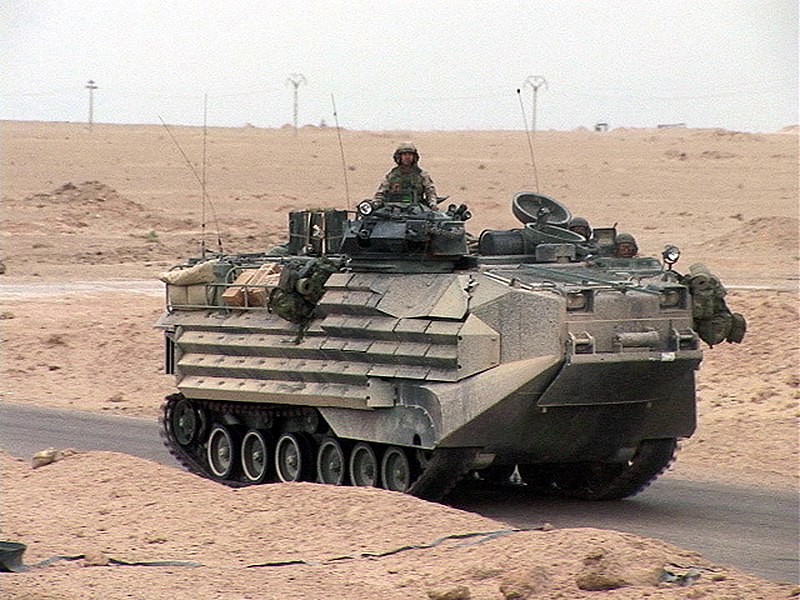 commanded by Lt. Col. Joseph W. Gibbs at 04:00 and slip into Laguna de Bay and head for Mayondon Point, near San Antonio, some two miles (3 km) from the camp. A Recon Platoon squad under Sgt. Leonard Hahn would mark and guide them to their landing point. Here they would travel overland and make their way to the camp, scheduling to arrive shortly after 07:00. They would then carry the internees back to Mayondon Point and make good their escape to Mamatid village.
commanded by Lt. Col. Joseph W. Gibbs at 04:00 and slip into Laguna de Bay and head for Mayondon Point, near San Antonio, some two miles (3 km) from the camp. A Recon Platoon squad under Sgt. Leonard Hahn would mark and guide them to their landing point. Here they would travel overland and make their way to the camp, scheduling to arrive shortly after 07:00. They would then carry the internees back to Mayondon Point and make good their escape to Mamatid village.
- Phase 4 involved the 188th Glider Infantry Regiment (minus its 2nd Battalion) and Company C of the 637th Tank Destroyer Battalion together with elements of the 472nd and 675th Field Artillery Battalions, under Colonel Robert H. Soule. The force would move down Highway 1 to act as a diversionary force and to engage the Japanese 8th Division, if necessary, so as to protect the flank.
Other guerrilla units such as Marking's Fil-American troops and the 48th Chinese Squadron were to set up road blocks in the towns of Calauan, Bay and Pila to delay possible Japanese reinforcements. The Hunters-ROTC 47th Regiment under Col. E. de Ocampo would do the same in the Calamba-Pansol area.
The backup 11th A/B pack howitzers in Calamba, Laguna, area was to bombard the road towards Los Baños. All the surrounding approaches and to the main camp would be secured. The townspeople were briefed and asked to vacate Los Baños by the local PQOG home-guard units.
Under cover of darkness on 21 February 1945, Lt. Skau and his 31-man platoon left the north shore of Laguna de Bay and headed across the lake in three bancas. Lt. Skau and six men led the way while the separate assault teams followed soon after. Avoiding Japanese patrol craft on the lake, they landed near Nanhaya and met with Lt. Miller's party, other local guerrillas and some camp escapees at the local schoolhouse. Included in the group were Freddy Zervoulakos and Benjamin Edwards, another young escapee, who sketched the layout of the camp on the schoolhouse blackboard. Lt. Skau decided to split his group into six teams, assigning a number of guerrillas to each team. Edwards and Zervoulakos each accompanied one team. On the night of 22 February, they journeyed through the jungle and rice paddies to their starting points, without alerting the Japanese, and were ready and waiting at 07:00 the next day.

At 04:00 on 23 February 1945 the 1st Battalion 511PIR (less B Company) boarded fifty-four amphibious tractors (Amtracs), slipped into Laguna de Bay, and headed for Mayondon Point. They also managed to reach their destination without alerting any Japanese defenders and headed off for the remaining 2 miles (3.2 km) overland journey to the camp, aiming to arrive just after 07:00.Hours before 07:00, guerrillas of the 45th Hunters-ROTC Regiment had stealthily assumed their designated positions around the camp, and they waited for Lt. Skau's Recon Platoon to signal the start of the assault.
Meanwhile, Lt. Ringler's B Company, 511th PIR together with the Light Machine Gun Platoon, had spent the moonless night of 22 February waiting at Nichols Field where, in the early dawn, they donned their parachutes, put on their equipment, and loaded onto nine C47s of the 75th Troop Carrier Squadron, under the command of Major Don Anderson, for the short flight. Flying unopposed by Japanese aircraft or antiaircraft fire, they soon arrived at their destination, which was clearly marked with white smoke by the Reconnaissance Platoon.
Some three minutes before 07:00, a lone Japanese sentry hunting possum among the bushes that shielded the waiting guerrillas shot at an animal, which was taken as a signal that the raiders were spotted. A Filipino guerrilla broke cover and hacked the sentry to death. Instantly, a wave of men charged the camp.
The Recon Platoon teams immediately swung into action. The assault team led by Sgt. Santos destroyed three pillboxes outside the main gate with automatic weapons fire. Sgt. Town's squad raked several guardhouses along the perimeter and decimated a patrol charging their position. Lt. Col. Ingles's guerrillas overran the camp perimeter and were battling Japanese guards at the rear of the camp. While Lt. Skau's platoon was heavily engaged with the guards at the main gate, some men popped colored smoke to mark the drop zone for the paratroopers.
At 07:00, coming in at the planned 500 feet (150 m) jump altitude and in three Vs-in-trail formation because of the small drop zone, Lt. Ringler's paratroopers dropped from their aircraft. While the ground forces were overcoming the perimeter defenses, B Company regrouped, killed some stragglers fleeing from the camp and helped subdue the remaining guards before they had a chance to respond in force. The firefight was short and intense. The Japanese were defeated and the internees freed.
Mindful of the need for speed, Lt. Ringler's men rounded up the internees as rapidly as they could. Some prisoners refused to leave, so Lt. Hettlinger's men burned the camp’s remaining huts, to encourage the internees to the Amtracs. At first, the disabled, along with the women and children, were loaded onto the waiting vehicles, while the more able internees formed a walking column and headed for the beach and freedom. As they made their way to the beachhead at San Antonio, in the distance they could hear heavy machinery. Thinking that Japanese tanks were approaching, a mass panic among the internees started, but they were relieved when the "tanks" turned out to be amphibious vehicles. On schedule, the fifty four Amtracs of the 672nd Amphibious Battalion arrived, guided by the signal flares and white smoke of Sgt. Hahn's squad.

In the distance, across the lake, intense fire was heard. That sound was from the Soule Task Force. Early that morning, the diversionary force of the 188th Glider Infantry Regiment and Company C of the 637th Tank Destroyer Battalion, together with elements of the 472nd and 675th Field Artillery Battalions under Soule, rolled out into Highway 1 and attacked across the San Juan River. They ran into Japanese opposition near the Lechería Hills where casualties were taken, but by mid-morning they had cleared the area and were marching towards Los Baños and cutting off the road between the Japanese 8th Tiger Division and Los Baños.
As the Amtracs started on the return trip, a hidden machinegun opened up and hit an Amtrac. Corporal Dwight Clark of the 672nd ATB returned fire with one of the Amtrac's .50-caliber machineguns and silenced the gunner before any of the civilians or rescuers were harmed.
From an elevated position, Soule could see, in the distance, the Amtracs on the beach heading back to Mamatid, so he ordered his force to conduct a defensive withdrawal and to re-establish its bridgehead across the San Juan River.

Finally, 2,147 former Allied POWs and internees, including three-day old baby girl Lois Kathleen McCoy, reached Mamatid. Frank Buckles was also among the prisoners; he had been captured as a civilian in Manila.

Two of Sgt. Santos's Recon Platoon members and four Filipino guerrillas were wounded. Two 188th Glider Infantry Regiment soldiers, , were killed at the Lecheria Hills engagement. The hand-to-hand skirmish was not without  casualties. A handful of guards were able to muster a makeshift defense, killing two young Hunter guerrillas, Pfc. Atanacio Castillo and Pfc. Anselmo Soler. Their bodies were recovered and buried beside the College chapel.
casualties. A handful of guards were able to muster a makeshift defense, killing two young Hunter guerrillas, Pfc. Atanacio Castillo and Pfc. Anselmo Soler. Their bodies were recovered and buried beside the College chapel.
 casualties. A handful of guards were able to muster a makeshift defense, killing two young Hunter guerrillas, Pfc. Atanacio Castillo and Pfc. Anselmo Soler. Their bodies were recovered and buried beside the College chapel.
casualties. A handful of guards were able to muster a makeshift defense, killing two young Hunter guerrillas, Pfc. Atanacio Castillo and Pfc. Anselmo Soler. Their bodies were recovered and buried beside the College chapel.
Firsthand accounts include that of former internee, Lewis Thomas Watty, vice president of the POW committee, who said:

The ensuing fight went on for very long minutes without letup, enemy defenders caught by total surprise were pinned and cut down mercilessly by liberator's fire. The Hunter experience through the years in irregular warfare paid off handsomely. It was also true of the paratroopers who were veterans of the South Pacific before they landed in Luzon.
A few days after the rescue, the Japanese in full force, led by the escaped Sadaaki Konishi, returned to Los Baños. Upon seeing that there were no POWs in sight, the Japanese turned their wrath on the remaining civilians in town who had failed to heed the warning from the guerrillas to leave. With the help of pro-Japanese MAKAPILI, the Japanese massacred some 1,500 men, women and children, and burned their homes, as well as those in the adjacent towns suspected of collaborating with the liberators. Konishi was tried for his war crimes after the war and hanged.

check out the blog above great.The vengeful massacre in the aftermath of the raid underlined the desperation of the Japanese army in their hopeless attempt to turn the fortunes of war. This campaign of ruthlessness was also reflected later in the concluded liberation of Manila and beyond, in the Pacific War.The outstanding success of the Los Baños raid incorporated many facets that revolutionized generations of future special military operations. Thorough planning, reliable intelligence, stealth, speed and surprise, superior firepower, cooperation by friendly forces, and support of the populace gave the planners and forces implementing the raid an advantage that resulted in few casualties.


No comments:
Post a Comment